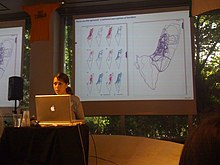Malkit Shoshan (born 1976[3]) is a designer, author, lecturer and founder of FAST, an architectural think tank that addresses "the relationships between architecture, urban planning, and human rights."[4]
Malkit Shoshan | |
|---|---|
 | |
| Born | 1976 |
| Nationality | Israeli and Dutch[1] |
| Alma mater | Technion – Israel Institute of Technology[2] |
| Occupation | Designer |
| Organization | Foundation for Achieving Seamless Territory (FAST) |
| Notable work | BLUE |
| Website | seamlessterritory |
Career
editShoshan studied architecture at the Technion – Israel Institute of Technology and the Istituto Universitario di Architettura di Venezia.
Her interest in cross-disciplinary and multi-scalar work exploring the impact of urban planning, and human rights in conflict and post-conflict areas started in 2005 when she founded FAST alongside Michiel Schwarz, Willem Velthoven and Alwine van Heemstra as a response to a request raised by a Palestinian community of internally displaced persons named Ein Hawd that needed a planning alternative to the one imposed by the Israeli government.[4]
In 2015, she was a finalist for the Wheelwright Prize, a $100,000 traveling fellowship awarded by the Harvard Graduate School of Design.[5] One year later, Shoshan was named curator of the Dutch Pavilion for the Venice Architecture Biennale with the exhibition "BLUE: Architecture of UN Peacekeeping Missions".[6]
In 2021, Shoshan won The Silver Lion at the Venice Biennale of Architecture for her collaborative project "Watermelons, Sardines, Crabs, Sands, and Sediments: Border Ecologies and the Gaza Strip."[7]
She is currently Area Head of the Art, Design, and the Public Domain Master in Design Studies at Harvard GSD[2] and a visiting scholar at the Institute for Public Knowledge at NYU.
Publications
editShoshan's book Atlas of Conflict: Israel-Palestine was published in 2010.[8] The book details Israel's emergence and Palestine's disappearance over the past hundred years.
She is the co-author of the book Village. One Land Two Systems and Platform Paradise (Damiani Editore), a series of narratives based on the Ein Hawd experience. Among other publications, Shoshan published BLUE: Architecture of UN Peacekeeping Missions (Actar) in 2023, a book based on the Dutch Pavilion she was curator of at the 2016 Venice Architecture Biennale. The publication "traces the complex processes and mechanisms" behind the conduct of United Nations peacekeeping missions.[9]
Her other publications include “Zoo, or the letter Z, just after Zionism” (NAiM, 2012), “Drone. UNMANNED. Architecture and Security Series” (Co-editor, DPR-Barcelona, 2016), “Retreat. UNMANNED. Architecture and Security Series” (Co-editor, DPR-Barcelona, 2020), “Spaces of Conflict” issue for Footprint, TU Delft Architecture Theory Journal (Co-editor, JAP SAM Books, 2017)and “UN Peace Missions in Urban Environments and the Legacy of UNMIL” (FAST, CIC-NYU, 2019).
References
edit- ^ a b Casale, Rocky (25 July 2016). "Malkit Shoshan on the Architecture of Diplomacy". SURFACE. Retrieved 23 April 2023.
- ^ a b "Faculty: Malkit Shoshan". Harvard University Graduate School of Design. Retrieved 23 April 2023.
- ^ "People". V2. Retrieved 23 April 2023.
- ^ a b "About Us". Foundation for Achieving Seamless Territory FAST. Retrieved 23 April 2023.
- ^ Madsen, Deane (2015-04-27). "Erik L'Heureux Wins 2015 Harvard GSD Wheelwright Prize". Architect Magazine.
- ^ Valencia, Nicolas (17 May 2016). "Malkit Shoshan on How the City is a Shared Ground for the Instruments of War and Peace". ArchDaily. Retrieved 23 April 2023.
- ^ Harrouk, Christele (30 August 2021). "UAE / Wetland Wins the Golden Lion for Best National Participation at the 2021 Venice Biennale". ArchDaily. Retrieved 23 April 2023.
- ^ Huisman, Jana (March 13, 2011). "The most beautiful book in the world by Jana Huisman". Atlas of the Conflict. Retrieved 23 April 2023.
- ^ "BLUE: Architecture of UN Peacekeeping Missions". Actar Publishers. Retrieved 23 April 2023.